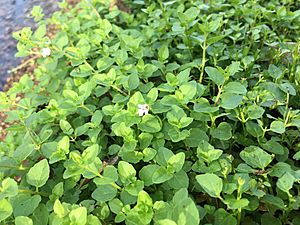Browne's savory facts for kids
Quick facts for kids Browne's savory |
|
|---|---|
 |
|
| Scientific classification | |
| Genus: |
Clinopodium
|
| Species: |
brownei
|
| Synonyms | |
|
|
Clinopodium brownei, also known as Browne's savory, is a small plant that lives for more than two years (a perennial). It has stems that spread out and are square-shaped. Its leaves grow in pairs directly opposite each other.
This plant is a type of herb. Its stems and the green parts that protect its flower buds (called the calyx) are quite hairy. The flower itself, called the corolla, looks like it has two lips. These lips are thin and delicate and might also have tiny hairs.
The flowers of Browne's savory can be pinkish-white, lavender, or sometimes pure white. Inside the flower, there are four parts called stamens, which help with reproduction. Below the flower, there seems to be a special gland that makes nectar.
Where Browne's Savory Grows
You can find Browne's savory in wet, marshy areas. It usually grows during late winter and early spring.
This plant is common along the coast of the southeastern United States. It grows from Texas all the way to South Carolina. You can also find it in Mexico, Central America, South America, and the West Indies.
See also
 In Spanish: Clinopodium brownei para niños
In Spanish: Clinopodium brownei para niños

